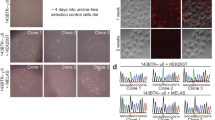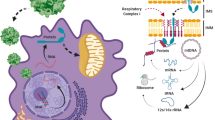ABSTRACT
Purpose
Development of a human mitochondrial gene delivery vector is a critical step in the ability to treat diseases arising from mutations in mitochondrial DNA. Although we have previously cloned the mouse mitochondrial genome in its entirety and developed it as a mitochondrial gene therapy vector, the human mitochondrial genome has been dubbed unclonable in E. coli, due to regions of instability in the D-loop and tRNAThr gene.
Methods
We tested multi- and single-copy vector systems for cloning human mitochondrial DNA in E. coli and Saccharomyces cerevisiae, including transformation-associated recombination.
Results
Human mitochondrial DNA is unclonable in E. coli and cannot be retained in multi- or single-copy vectors under any conditions. It was, however, possible to clone and stably maintain the entire human mitochondrial genome in yeast as long as a single-copy centromeric plasmid was used. D-loop and tRNAThr were both stable and unmutated.
Conclusions
This is the first report of cloning the entire human mitochondrial genome and the first step in developing a gene delivery vehicle for human mitochondrial gene therapy.



Similar content being viewed by others
Abbreviations
- ARS:
-
autonomous replicating sequence
- BAC:
-
bacterial artificial chromosome
- D-loop:
-
displacement loop
- mtDNA:
-
mitochondrial DNA
- PAC:
-
P1 phage artificial chromosome
- TAR:
-
transformation-associated recombination
- TB:
-
terrific broth
REFERENCES
Larsson NG, Luft R. Revolution in mitochondrial medicine. FEBS Lett. 1999;455(3):199–202.
Chinnery PF, Johnson MA, Wardell TM, Singh-Kler R, Hayes C, Brown DT, et al. The epidemiology of pathogenic mitochondrial DNA mutations. Ann Neurol. 2000;48(2):188–93.
Elliott HR, Samuels DC, Eden JA, Relton CL, Chinnery PF. Pathogenic mitochondrial DNA mutations are common in the general population. Am J Hum Genet. 2008;83(2):254–60.
McFarland R, Taylor RW, Turnbull DM. A neurological perspective on mitochondrial disease. Lancet Neurol. 2010;9(8):829–40.
Bigger B, Collombet JM, Coutelle C. Tipping the scales in favour of mitochondrial gene therapy [comment]. Gene Ther. 1999;6(12):1909–10.
Doyle SR, Chan CK. Mitochondrial gene therapy: an evaluation of strategies for the treatment of mitochondrial DNA disorders. Hum Gene Ther. 2008;19(12):1335–48.
Kyriakouli DS, Boesch P, Taylor RW, Lightowlers RN. Progress and prospects: gene therapy for mitochondrial DNA disease. Gene Ther. 2008;15(14):1017–23.
Tapper DP, Van Etten RA, Clayton DA. Isolation of mammalian mitochondrial DNA and RNA and cloning of the mitochondrial genome. Methods Enzymol. 1983;97:426–34.
Bigger B, Tolmachov O, Collombet JM, Coutelle C. Introduction of chloramphenicol resistance into the modified mouse mitochondrial genome: cloning of unstable sequences by passage through yeast. Anal Biochem. 2000;277(2):236–42.
Bigger BW, Tolmachov O, Collombet JM, Fragkos M, Palaszewski I, Coutelle C. An araC-controlled bacterial cre expression system to produce DNA minicircle vectors for nuclear and mitochondrial gene therapy. J Biol Chem. 2001;276(25):23018–27.
Wheeler VC, Aitken M, Coutelle C. Modification of the mouse mitochondrial genome by insertion of an exogenous gene. Gene. 1997;198(1–2):203–9.
Katrangi E, D’Souza G, Boddapati SV, Kulawiec M, Singh KK, Bigger B, et al. Xenogenic transfer of isolated murine mitochondria into human rho0 cells can improve respiratory function. Rejuvenation Res. 2007;10(4):561–70.
Mita S, Monnat Jr RJ, Loeb LA. Resistance of HeLa cell mitochondrial DNA to mutagenesis by chemical carcinogens. Cancer Res. 1988;48(16):4578–83.
Mita S, Monnat Jr RJ, Loeb LA. Direct selection of mutations in the human mitochondrial tRNAThr gene: reversion of an ‘uncloneable’ phenotype. Mutat Res. 1988;199(1):183–90.
Shuster RC, Rubenstein AJ, Wallace DC. Mitochondrial DNA in anucleate human red blood cells. Biochem Biophys Res Comm. 1988;155(3):1360–5.
Andrews RM, Kubacka I, Chinnery PF, Lightowlers RN, Turnbull DM, Howell N. Reanalysis and revision of the Cambridge reference sequence for human mitochondrial DNA [letter]. Nat Genet. 1999;23(2):147.
Ioannou PA, Amemiya CT, Garnes J, Kroisel PM, Shizuya H, Chen C, et al. A new bacteriophage P1-derived vector for the propagation of large human DNA fragments. Nat Genet. 1994;6(1):84–9.
Larionov V, Kouprina N, Eldarov M, Perkins E, Porter G, Resnick MA. Transformation-associated recombination between diverged and homologous DNA repeats is induced by strand breaks. Yeast. 1994;10(1):93–104.
Larionov V, Kouprina N, Graves J, Chen X-N, Korenberg JR, Resnick MA. Specific cloning of human DNA as yeast artificial chromosomes by transformation-associated recombination. Proc Natl Acad Sci USA. 1996;93(1):491–6.
Newlon CS. Yeast chromosome replication and segregation. Microbiol Rev. 1988;52:568–601.
Stinchcomb DT, Mann C, Selker E, Davis RW. DNA sequences that allow the replication and segregation of yeast chromosomes ICN-UCLA Symp. Mol Cell Biol. 1981;22:473.
Huang RY, Kowalski D. A DNA unwinding element and an ARS consensus comprise a replication origin within a yeast chromosome. EMBO J. 1993;12(12):4521–31.
Kouprina N, Annab L, Graves J, Afshari C, Barrett JC, Resnick MA, et al. Functional copies of a human gene can be directly isolated by transformation-associated recombination cloning with a small 3′ end target sequence. Proc Natl Acad Sci USA. 1998;95(8):4469–74.
Clarke L, Carbon J. Isolation of a yeast centromere and construction of functional small circular chromosomes. Nature. 1980;287(5782):504–9.
Keith JM, Cochran DA, Lala GH, Adams P, Bryant D, Mitchelson KR. Unlocking hidden genomic sequence. Nucleic Acids Res. 2004;32(3):e35.
Botstein D, Falco SC, Stewart SE, Brennan M, Scherer S, Stinchcomb DT, et al. Sterile host yeasts (SHY): a eukaryotic system of biological containment for recombinant DNA experiments. Gene. 1979;8(1):17–24.
Beggs JD. Transformation of yeast by a replicating hybrid plasmid. Nature. 1978;275(5676):104–9.
Kazakova TBM, Babich SG, Golovina GI, Mel’nikova MP, Tsymbalenko NV. [Autonomous replication of plasmid pBR322 containing a mitochondrial DNA fragment of animal origin in the cells of bacteria mutant for DNA- polymerase I]. Genetika. 1983;19(3):381–7.
Zakian VA. Origin of replication from Xenopus laevis mitochondrial DNA promotes high-frequency transformation of yeast. Proc Natl Acad Sci USA. 1981;78(5):3128–32.
Palzkill TG, Newlon CS. A yeast replication origin consists of multiple copies of a small conserved sequence. Cell. 1988;53(3):441–50.
Rashid MB, Shirahige K, Ogasawara N, Yoshikawa H. Anatomy of the stimulative sequences flanking the ARS consensus sequence of chromosome VI in Saccharomyces cerevisiae. Gene. 1994;150(2):213–20.
ACKNOWLEDGMENTS & DISCLOSURES
This work was supported by the Cystic Fibrosis Trust Muller Bequest to CC. BWB, AYL and AS are supported by the UK society for Mucopolysaccharide diseases and the Manchester Biomedical Research Centre.
Author information
Authors and Affiliations
Corresponding author
Electronic supplementary materials
Below is the link to the electronic supplementary material.
Supplementary Table 1
PCR and sequencing primers (DOCX 21 kb)
Supplementary Table 2
PCR conditions (DOCX 12.8 kb)
Rights and permissions
About this article
Cite this article
Bigger, B.W., Liao, AY., Sergijenko, A. et al. Trial and Error: How the Unclonable Human Mitochondrial Genome was Cloned in Yeast. Pharm Res 28, 2863–2870 (2011). https://doi.org/10.1007/s11095-011-0527-1
Received:
Accepted:
Published:
Issue Date:
DOI: https://doi.org/10.1007/s11095-011-0527-1




